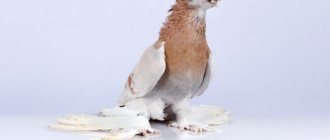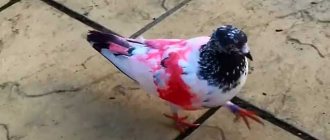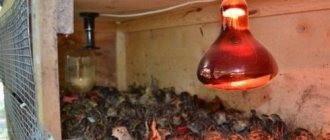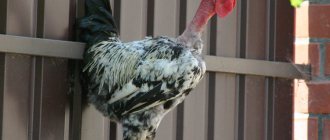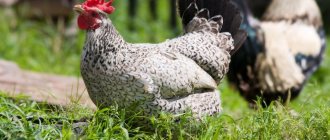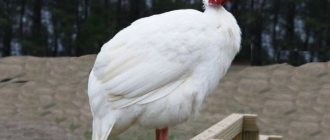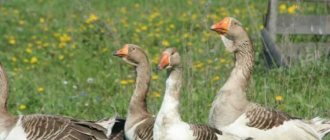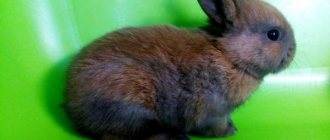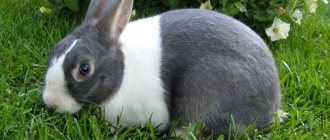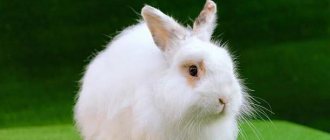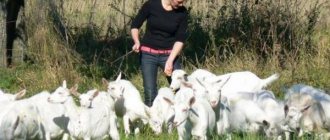In general, all these bird species are very similar, but at the same time they have their own standards and specific differences. What all these birds have in common is the difficulty of breeding and caring for them. Pouting pigeons are very demanding to keep; they require a lot of attention and care from their breeder. In order to maintain the purity of the species, it is necessary to carry out a careful and strict selection of chicks, which is not so easy, because these pigeons are not fertile and have weak genetics. For example, breeding a line with a certain color of feathers on the head may take too much time, often taking more than 1 year.
Each species has its own standards and require strict guidelines; culling in the breed occurs quite often. In this breed, it is unacceptable for the bird to have legs that are too short or too closely set, as well as a short body or a crop that is inseparable from the torso. For selective breeding of this breed, it is necessary to carefully and strictly select young animals to maintain a pure breed.
Main criteria and standards
In their appearance, these birds give the impression of little proud people who puff out their chests and walk majestically on their shaggy legs. The blowers have a fairly large body with an almost vertical arrangement. With a large body, they have a small rounded head with a slightly convex forehead. The plumage has different colors from pure white or black, to gray, colored and silver. The neck of this breed is long, smoothly turning into a craw, spherical in shape and it tapers slightly at the chest.
You can recognize a pigeon of this breed by its characteristic fluffy breast.
Corresponding to their size, pouting pigeons have large wings, which are located along the entire body and, without crossing, lie on the tail of the bird. Their legs are covered with light feathers, forming so-called trousers. For all its important and strong appearance, this variety is weak and poorly mobile. Pouters fly reluctantly and rarely.
The size of each breed can vary quite a lot; for example, the legs of the English pouter can reach a height of up to 15 cm, and the total height can exceed 45-50 cm. In addition to the large representatives of this species, many pigeon breeders prefer the dwarf species.
Description and care of pigeons of the “Dutysh” breed
Almost all pigeon breeders dream of having such a breed as the “Poutysh” pigeon in their live collection. These pigeons have a rather memorable and bright appearance. By nature, these birds are not aggressive; their calm and cautious disposition makes them easily vulnerable.
Some experts do not recommend housing pouters with other types of pigeons; quite often there have been cases of injury to the crop of these pigeons. After all, the main feature of this breed is precisely the ability to inflate its crop to such a size that sometimes even the beak is not visible behind it. This breed was developed in Belgium and Holland. Today the most common and popular varieties of puffers are:
- Great English.
- Brno.
- Saddle Czech.
- Pomeranian.
Each species has its own standards and require strict guidelines; culling in the breed occurs quite often. In this breed, it is unacceptable for the bird to have legs that are too short or too closely set, as well as a short body or a crop that is inseparable from the torso. For selective breeding of this breed, it is necessary to carefully and strictly select young animals to maintain a pure breed.
Read also: How to grow verbascum on a plot
Care and maintenance
The breed is considered very whimsical and requires a lot of attention and labor to care for. Birds that are strong in appearance have a weak immune system. They are susceptible to many diseases. The dovecote should be dry and draft-free; if pigeons are kept in a cage, then you should also ensure that there are no drafts for them. The appearance of dampness in the dovecote is unacceptable; the temperature in the cold season should not be lower than 5-6 °C, and in the hot season no more than 20 °C.
The bird must have water available at all times. It is best to make a drinking bowl made of ceramic or glass. Pigeons feed mainly on dry food, these are cereals and plant seeds, so their body needs to consume a large amount of liquid.
Pigeons must be kept in clean cages or enclosures, where there are completely no drafts.
The water in the drinking bowl should be changed daily and should not be given too cold. It is the dishes from which pouting pigeons drink and feed that should be given a lot of attention, namely, they should be washed regularly with special disinfectants, such as chloramine. Feeders, drinking bowls and baths can be cleaned regularly. General disinfection in the dovecote is carried out 2 times a year in accordance with the requirements of the veterinary service.
Each breed requires care not only a lot of time and attention, but most importantly, love for birds. Pigeons are distinguished by their affection and devotion to loving owners.
Features and habitat of the pigeon
Many modern breeds of pigeons are descended from the ancestor - the rock pigeon. It is still well known and widespread in Europe, Asia, and Africa. The entire Eurasian territory has been developed by the pigeon tribe; the birds live even in high mountain areas with a cool climate.
Pictured is a rock pigeon
The main condition is places cultivated by man or their close location. The dove is the bird of peace, as it is called in different parts of the world. Wild relatives inhabit steep river banks, coastal cliffs, and gorges.
Pigeon nests can be found in small recesses and caves. The presence of agricultural land or human habitation has always attracted birds as food sources, so relationships with humans have been formed over many centuries.
Based on numerous species of birds - there are more than 30 - hundreds of breeds of domesticated pigeons have been bred. Sizes and plumage vary, although there are traditional and recognizable birds: ash-gray birds with a purple or green tint. White doves are the objects of photo shoots and holiday shows.
In the photo there is a white dove
Experts count more than twenty shades of plumage, and this list is constantly growing. The sign of a male among pigeons is an enhanced dark metallic color. Females are always brighter and lighter. Young pigeons do not immediately acquire bright colors; the richness of bright plumage accumulates in adults.
Large pigeons can be compared in size to a chicken, and small ones are barely larger than a sparrow. The maximum weight is about 400 g. The wings of birds are large and strong, with a wide span. The feathers and down covering pigeons are weak and often fall out.
In permanent places where pigeons gather, as a rule, there are always a lot of dropped feathers and fluff blown by the wind. The abundance of droppings left behind after a bird feast prompts residents to systematically scare away the birds. Pigeons are not only driven out, they are even exterminated.
The photo shows a dove in flight
Many people love pigeons for their gentle cooing, melodious sounds that accompany the courtship period. Poultry pigeons can whistle, hum, hiss angrily and even scream. The vocal palette is rich and varies depending on the period, age and condition of the bird.
Listen to the voice of the dove
Listen to the cooing of a dove
Character and lifestyle of a pigeon
The dove has always been considered a peace-loving and gentle bird. But she has enough enemies in nature. In the forests these are foxes, raccoons, owls, peregrine falcons, eagle owls, and in the city they are hunted by dogs and cats. Birds die from sudden cold weather, infectious diseases, and from the rash actions of people whom pigeons easily trust.
Pigeons live in flocks, small colonies. In warm places they are characterized by a sedentary lifestyle, but in seasonal cold conditions they can fly to more comfortable regions for the winter. Living together helps survival. Together it is easier to resist the enemy or feed yourself.
Wild pigeons, like other birds, are cautious and shy. Vision and hearing are well developed. In urban areas, fed by humans, they lose their vigilance and can peck food from the palms of their hands, especially in the cold season.
Wild pigeons prefer rocky places near water bodies, where there are few plants, so they do not even know the ability to sit on branches. Birds living in urban areas settle under the roofs of tall buildings. This is a kind of reminder of our ancestors about their native shores. The presence of food near the home encouraged the birds to settle in the trees.
You can often see pigeons leisurely walking around squares or along roads. It is not difficult to scare away pigeons; they soar noisily and occupy peaks inaccessible to humans. The flight of pigeons is beautiful; they can circle in the air, captivating with their freedom.
It is no coincidence that they were used as postmen; birds can reach speeds of up to 180 km/h, and cover distances of up to 1000 km per day. Tenacious memory allows you to accurately return to your native places. Their flight altitude reaches 3000 m; higher rarefied air makes it difficult for birds to move.
In the photo there is a wild pigeon
It is interesting to observe pigeons in the air. When it is necessary to stop its rapid movement, the pigeon opens its tail in a “butterfly” manner, braking in a peculiar way in the air and hovering in place. When threatened with an attack by a bird of prey, the pigeon folds its wings and flies down like a stone at a speed of up to 80 km/h. The wings connected at the top promote movement in a circle.
The tail acts as a rudder to control movement in the air.
It is no coincidence that on special occasions pigeons are released in order to draw attention to the beauty and perfection of their flight.
Origin
The history of the origin of the breed is controversial: most poultry farmers consider Holland or Belgium to be their homeland, where pigeons were on a wave of popularity in the 16th century. However, there is written information dating back to 1345 that mentions Spanish pigeons inflating the crop.
Since from the beginning of the 16th century Spain was under the rule of the Habsburg dynasty, it is quite logical to assume that the pouts came to Europe through the countries that were part of the Austro-Hungarian Empire.
Content
As an ornamental breed, it can be kept in any convenient conditions. However, if flight qualities are required, then a dovecote with a notch and the ability to regularly launch birds into flight are needed. Otherwise, the bird is not very whimsical; it does not have any special requirements, except for regular flight training.
Breeding pigeons for meat as a business. Nuances of the organization and real income figures
Article
Breeding pigeons at home for beginners. How to gain experience
More details
Birds of prey that pigeons are afraid of. Reminder for pigeon breeder
Article
Basic information that a poultry farmer needs to know about the physiology of pigeons
Read
Rules for keeping pigeons: what should be in the dovecote and how to organize the feeding regime
More details
Artificial incubation of pigeon eggs: what are the features of the process and what to do after the chicks hatch
Read
General characteristics of the breed
Over several centuries, as a result of selection, more than twenty varieties of pouters have appeared: miniature and large, bare-legged and with pants, with a huge palette of shades in color.
But there are many general characteristics that remain specific to this breed:
- ability to swell goiter;
- extended body;
- narrow long wings;
- a long tail;
- poor flight qualities.
high frontal part;
Description of varieties
Let's consider a description of the varieties of puffers that are most popular among poultry farmers.
Great English
Description of the breed:
- body - large, length up to 50 centimeters, vertical stand;
- head - oval-shaped, small;
- the beak is long, the wax is light, not large, but well defined;
- eyes - dark in individuals of light color, yellow or orange in individuals with dark plumage;
- neck - long, noticeably narrowed closer to the chest;
- chest - narrow;
- the back is straight with a depression in the shoulder area;
- wings - fit tightly to the body, not crossed on the tail;
- the tail is rounded at the end, the tail feathers are wide;
- paws - length from hip to toe up to 18 cm, there are long, up to 5 cm, feathers (5–12 pieces), forming plate-shaped scutes;
- color - snow-white, gray, black, yellow, brown-red, fawn. With a colored coat, there are spots and a crescent-shaped pattern on the crop.
Brno
Brno Saddlebacks are distinguished by their jumping gait. In addition, birds can swell their crop so much that their beak practically drowns in it.
Description of the species:
- the body is long and elongated;
- the head is oblong with a flat crown;
- beak - thin with a curved upper beak;
- eyes - with a light color they are almost black, in other cases they have a yellow tint;
- neck - curved with a spherical goiter;
- chest - narrow, long;
- the back is elongated, narrower at the shoulders;
- wings are long, crossing at the tail;
- the tail is about 2 centimeters longer than the wings;
- paws - from hip to middle toe 12 cm, without shields;
- color - black, white, gray, yellow, red, colored. Gray specimens are belted with black, while colored ones are belted with white.
Saddle Czech
The saddleback variety is considered one of the oldest in pigeon breeding in the country. They were bred in Moravia, Brno, and bred for exhibitions.
The bird looks like this:
- body - up to 37 cm in length;
- head - smooth, not large;
- beak - wedge-shaped, curved, with a small wax;
- eyes - almost black, may have a red tint;
- neck - long, with a pear-shaped goiter;
- chest - wide;
- the back is broad at the shoulders, inclined, tapering downwards;
- wings - narrow, closed, tight-fitting;
- tail - smoothly continues the line of the back;
- paws - up to 17 cm long, scutes long and fluffy;
- color - two-color, in combination with a white shade it can be yellow, gray, reddish, the main feature is a colored stripe on the head.
Pomeranian
The main difference between the Pomeranian varieties is the large body and the throwing back of the head when the crop swells.
Description:
- body - length up to 52 cm;
- head - smooth, medium size;
- the beak is strong, in individuals with light plumage the color of coffee with milk, in others it is almost black;
- eyes - dark or yellow in light-colored specimens;
- neck - long, with a large goiter;
- chest - wide, especially in the lower part of the body;
- back - with a small depression in the shoulder area, equally wide along the entire length;
- wings - closed, almost equal to the length of the tail;
- tail - with a rounded tip, wide;
- paws are long, covered with small feathers up to 14 cm long;
- color - white, two-color (white-gray, white-black), yellow, red. There may be a spot in the shape of a heart or a crescent on the crop; gray-gray individuals have a dark belt.
Dwarf
The dwarf specimen appeared as a result of crossing the Greater English and Brno blower. Outwardly, it completely repeats the Great English parent, with the exception of body length - it is only 35 centimeters.
Otherwise, it is proportionally built, has a wide crop, long narrow wings and a developed tail with wide tail feathers. Its paws are feathered, its hip is set vertically, and its tail does not touch the ground. The head is not large, smooth, with brown or orange eyes and a beak colored in the color of the plumage.
Kinds
To breed birds, you can choose from two dozen varieties of this breed, one or more - as desired. It is possible to keep pouters together, but it is problematic with other pigeon representatives.
Saddle Czech
A pigeon from Moravia, namely the city of Brno. This is one of the oldest breeds in Czechoslovakia. The birds are rather large (up to 45 cm long) with a medium-sized head that does not have a crest. The body is harmonious, and the tail continues the back, the chest and shoulders are wide.
The wings are of medium length, as expected, close together and lie on the body. In the rear third of the body there are legs, long - 15-17 cm - densely feathered. The Saddleback Pigeon's eyes are black or some other dark shade, but are sometimes tinged with red. Eyelids flesh-colored or red.
The goiter is large and wide, resembling a pear. The beak is strong, wedge-shaped and slightly curved at the end. A small light cere fits tightly to it.
The color of the beak matches the color of the plumage, which is two-colored. It can be yellow, black, gray or red. At the same time, other parts of the body remain white, for example, the stomach, paws, wings, etc. There is a colored stripe on the head that covers the crown and forehead. This is the main characteristic of the saddle-backed pigeon.
Brno
These pigeons also come from the Czech Republic - Brno and Prague, but are not similar in size to their predecessors.
The dwarf variety of pouters has a body length of only 32-35 cm (males and females). The bird's stance is straight, but the tail does not touch the ground. The wings cross, and if the back is narrow, they lag behind the body.
The legs are long. The figure is slim. When the Brno pigeon straightens up, it seems that its body below the crop is tied with a belt. The goiter itself is of the correct spherical shape.
The color of this species of birds is distinguished by a wide variety of patterns. Among the Brno breeds there are single-colored and belted individuals, storks and speckled ones.
Belts of pouters come in white and black, and one color (it is always very bright) is found in individuals of the following colors:
- yellow;
- red;
- black;
- pale yellow;
- blue;
- silver, etc.
Pigeons are interesting for their temperament and elegant constitution. The cooing of the Brno puffers is not as deep and loud as that of its relatives. The voice sounds higher.
When a male is courting a female, he does not just coo, but jumps, stepping only on her toes. At the same time, it does not bend at an angle of 45°, but maintains a vertical position of the body. This species flies well, so the birds can be trained.
Pomeranian
Pomeranians were bred in the 19th century in Vorpommern on the island of Rügen in the Baltic Sea. The breeders took birds from Holland, England and Belgium as a basis.
In 1869, the variety received its official name. The Pomeranian is a powerful, large representative of the breed (reaches 50-52 cm). His body is slender, his posture is beautiful, his head is without tufts. The wings are adjacent to the body.
The tail is a little full. The legs have shaggy feathers with long (up to 14 cm) feathers. The goiter is huge, pear-shaped. The peculiarity of the species is the throwing back of the head when the crop is inflated.
The beak of Pomeranian pouters is small, similar in color to the plumage: beige in light ones, dark brown in others. Eye color also depends on the color of the bird.
The following types of plumage are common:
- pure white without adding other shades;
- white with a colored tail, such as gray and black;
- colored - red, black, yellow, gray, having dark belts on the shields or a white heart on the crop;
- multi-colored with white legs, tail, belly and wing tips.
Great English
A purebred representative of the species. Like Pomeranian pigeons, these pigeons are large representatives of pouters. Breeders bred them in the 17th century from Dutch and Roman breeds.
They had a huge impact on pigeon breeding, being used to breed other varieties of pigeons and improve pouters.
The exterior of the British is as follows:
- Individuals grow up to 40-50 cm in length.
- They have an oval smooth head and a slightly convex forehead.
- Almost vertical stance with an elastic, well-developed crop.
- Next to the strong beak is a small wax, the color of which is the color of the plumage and seems to be powdered.
- The waist is thin, with a vest (that's what its front part is called).
- The back is in line with the tail. A clear depression between the shoulders.
- The wings are tightly closed and lie flat on the tail, which is rounded at the end.
- The legs are set close together, their length is about 18 cm from the hip to the middle toe. The feathering on the legs is short, the feathers on the toes form a so-called “plate”.
The plumage of English pouters ranges from white to black (e.g., reddish, yellow, glaucous, silver). There are birds without patterns - that is, pure white without impurities. Colored individuals have a white belly, flight feathers, and chest (crescent).
And on the wing shields there are “epaulets” made of small feathers, which can number from 5 to 12. Birds are valued all over the world for their beautiful appearance. Despite their large size, pigeons are active and love to rise and soar in the sky.
Dwarf
Some varieties of pouters are classified as dwarf. But this dwarfism is only in comparison with other, larger representatives of the breed.
For example, English dwarfs reach a length of 32-34 cm versus 50 cm (the average size of English ones). Brno dogs are also considered miniature. Both of these varieties have long legs. And the puffers bred in Amsterdam are the Amsterdam (Dutch) spherical ones - short-legged.
Typically, the characteristic “dwarf” refers to English pouters. For the first time, miniature individuals became known in the 80s of the 19th century; they were the result of crossing Brno and English pigeons.
Outwardly, they completely repeat the British ancestor, the only differences are in size. The peculiarity of the breed is that it is kept entirely in an aviary; these birds are extremely thermophilic. You can even start them in an apartment.
Short-legged Dutch birds are popular in their homeland, the Netherlands. Their size is average, no more than 35 cm. The crop has the traditional shape of a ball, the body is smooth, the legs are of medium length, the head is without a forelock.
The beak is thin and short, and the eyes match the color of the bird: in light-colored individuals they are brown, in others they are shades of yellow and red.
The plumage of dwarf short-legged pouters can be of different colors: silver, blue, black or white. There are individuals with a speckled pattern and a belt on the body.
Conditions of care and maintenance
To keep birds, they build a dovecote, counting on a density of half a square meter per individual. For the summer season, a mesh enclosure is built so that pets can enjoy fresh air.
Room
The room for birds should be warm and dry; drafts and dampness are contraindicated. Comfortable temperature is not lower than +5°C and not higher than +20°C. If the number of birds is more than 10, the room should be divided into sections due to the pugnacious nature of the pouters.
It is imperative to arrange perches, about 30 cm of space per individual, about 3 cm thick. It is also worth considering the comfortable location and number of drinkers and feeders. The water should always be clean, so it is important to choose the appropriate design of drinking bowls.
Origin story
It is believed that this unusual breed originated in Western Europe. The peak of popularity came in the 16th century, when such pigeons began to be bred most actively in Belgium and the Netherlands. However, controversy often arises around this version, since, according to some information, in the middle of the 14th century in Spain, pigeons were often seen inflating their crops, which is a distinctive feature of pouters.
Work on breeding and crossing pouts with other breeds continued for several hundred years. Currently, there are more than 20 varieties, but breeders do not stop there.
Work is carried out in different parts of the globe, but the most popular types still originate from European countries.
Characteristics and Features
The distinctive characteristics of this breed stand out based on the varieties of pigeons. Each species may have differences in growth, color, and appearance. However, in all cases there are strict criteria and standards, non-compliance with which leads to the rejection of individuals.
However, there are also general characteristics characteristic of the Pouter breed. The main one is the ability to very strongly inflate the crop, into which the spherical neck passes. The pigeons have a medium build and have a characteristic fluff on their chest. The body is located almost vertically, the wings lie on the long tail without crossing. Some varieties have feathering on their legs. The color of birds is varied, they can be black, white, gray or colored.
Compliance with standards is mandatory if a pigeon breeder decides to take part in exhibitions. There are acceptable deviations from the norm or deficiencies, after which the birds are not allowed to compete.
Breed varieties
One of the advantages of blowers is the ability to contain several varieties under one roof. This is not acceptable for all breeds. Among the blowers, there are especially popular types; let’s look at them in more detail.
Saddle Czech
This breed originates in the city of Brno. Large birds, whose body is very harmonious and reaches 45 centimeters. The shoulders are wide, and the wings close and lie along the body. The long legs have dense feathering. The eyes are very dark, can be tinted red, and are closed with thin eyelids.
The pigeon's crop is impressive, pear-shaped. Birds usually have a double color, predominantly yellow, gray, red or the standard black. The powerful beak ends in a bend at the tip; its shade matches the main one. Some elements are white, for example, the legs, wings and belly. A distinctive feature of the variety is the characteristic bright stripe located on the head.
Brno
As with the previous species, the Czech Republic is considered the birthplace of the Brno pigeon. The birds vary in size and belong to the dwarf species. The maximum length of their body is 35 centimeters.
Despite the straight stance, the tail of the birds does not come into contact with the ground.
The bird has a slender figure and long legs. The goiter resembles a ball in shape. You can see many patterns in the color of the Brno pigeon; single-color birds, belted birds, speckled birds and others are popular. Among monochromatic colors, saturated blue, silver, red, yellow and black are especially popular.
The birds have a high-pitched voice and their cooing is quite quiet. During courtship, the pigeon jumps around the female on its toes in a vertical position. The birds have good flying abilities, so pigeon breeders have the opportunity to organize classes and training with their pets.
Pomeranian
According to the name, this type of pout was bred in Pomerania and begins its history in the mid-19th century. The basis was pigeons from countries such as Belgium, Holland and England.
Pomeranian pigeons are very impressive in size. Their length can reach up to 52 centimeters. At the same time, the birds have a beautiful posture, a slender figure and a smooth head. The tail is slightly curled.
Pigeons have fluffy feet; the length of the feathers here can reach 14 centimeters. The huge crop is pear-shaped. A distinctive feature is that while the crop is inflated, the inflators throw their heads back. The color of the beak depends on the basic shade of the feathers. Light-colored individuals have a flesh-colored beak, while darker ones have a rich brown beak.
The color of this variety is varied. There are snow-white Pomeranian pigeons or, with a basic white color, having bright tails. There are also red, yellow, gray representatives of the breed, multi-colored individuals or those with a pattern in the form of a white heart on their crop.
Popular breeds
Butterfly pigeons are very beautiful. They are also called Nikolaev butterflies because these birds were bred in the city of Nikolaev in Ukraine. Pigeons have a strong build, a wide tail, long wings and a luxurious chest. But the goal of the breeders was not at all external beauty, but to obtain birds that could endure a long flight. And they successfully succeeded. The Nikolaev breed of pigeons was developed. These birds are distinguished by their endurance and are able to spend almost 6 hours in the sky per day. Nikolaev butterflies fly very beautifully, performing different types of flight.
Premises requirements
Birds of this breed are quite demanding in terms of living conditions. Pigeon breeders know that breeding pouters can be a very troublesome task. It is necessary to take into account the characteristic features and nuances.
It should be noted that the character of pouters is quite complex. Males have a tendency towards pugnacity. In addition, keeping this breed with others can cause significant problems, so this is not recommended.
In a fight, birds can puncture the crop, which can even lead to the death of a pigeon.
Pouters have a fairly strong body structure, however, their immune system is very delicate, which can lead to various diseases. The babies of this breed are weak, so it is necessary to ensure the cleanliness and dryness of the room where they will be kept. Any drafts should also be excluded. In cases where the cage is open, it must be protected from wind and scorching sun.
In winter, the indoor temperature should not fall below +5 degrees, in summer it should stay at around +20 degrees. Once every 6 months it is necessary to do a general thorough disinfection.
Feeding and diet
Due to the fact that pouter pigeons are flightless birds, their muscles are sluggish, and the esophagus is underdeveloped, so the daily dose of feeding for them should not exceed 45 grams of dry food per head.
In winter, it is recommended to feed pigeons a mixture of barley and crushed oats, where barley is 65-70%, oats - 30-35%. You can add 10% crushed corn and 10% lentils to the oat-barley mixture.
A mixture of potatoes boiled in salt water with wheat bran, crushed lime and clover flour has a high nutritional value for pigeons. And in order to preserve the elasticity and softness of their body plumage in the doves during the winter, you need to feed the birds very well with flax and rapeseed in an amount of no more than 50 grams per 15 pairs.
Water in drinking bowls should be available around the clock.
But it is recommended to remove feeders with grain food at night to prevent overfeeding and further obesity of females, which threatens the development of infertility.
To prevent sexual arousal in chicks during the winter months, they should not be fed corn, peas, beans and vetch, but during the mating period they must be included in the feeding diet.
